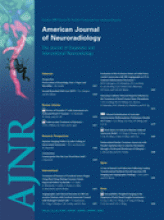Review ArticleReview Articles
Open Access
Endovascular Treatment of Epistaxis
P.W.A. Willems, R.I. Farb and R. Agid
American Journal of Neuroradiology October 2009, 30 (9) 1637-1645; DOI: https://doi.org/10.3174/ajnr.A1607
P.W.A. Willems
R.I. Farb

References
- 1.↵
- Small M,
- Murray JA,
- Maran AG
- 2.↵
- 3.↵
- Walker TW,
- Macfarlane TV,
- McGarry GW
- 4.↵
- 5.↵
- 6.↵
- Koh E,
- Frazzini VI,
- Kagetsu NJ
- 7.↵
- 8.↵
- Viducich RA,
- Blanda MP,
- Gerson LW
- 9.↵
- Monte ED,
- Belmont MJ,
- Wax MK
- 10.↵
- Pollice PA,
- Yoder MG
- 11.↵
- Klotz DA,
- Winkle MR,
- Richmon J,
- et al
- 12.↵
- Schaitkin B,
- Strauss M,
- Houck JR
- 13.↵
- 14.↵
- 15.↵
- 16.↵
- Snyderman CH,
- Goldman SA,
- Carrau RL,
- et al
- 17.↵
- Sokoloff J,
- Wickbom I,
- McDonald D,
- et al
- 18.↵
- Lasjaunias P,
- Marsot-Dupuch K,
- Doyon D
- 19.↵
- Elden L,
- Montanera W,
- Terbrugge K,
- et al
- 20.↵
- Tseng EY,
- Narducci CA,
- Willing SJ,
- et al
- 21.↵
- Berenstein A,
- Lasjaunias P,
- Terbrugge K
- 22.↵
- Osborn AG
- 23.↵
- Vitek J
- 24.↵
- Duncan IC,
- Spiro FI,
- van Staden D
- 25.↵
- 26.↵
- 27.↵
- Ashwin PT,
- Mirza S,
- Ajithkumar N,
- et al
- 28.↵
- Gurney TA,
- Dowd CF,
- Murr AH
- 29.↵
- Duncan IC,
- Fourie PA,
- le Grange CE,
- et al
- 30.↵
- 31.↵
- 32.↵
- Christensen NP,
- Smith DS,
- Barnwell SL,
- et al
- 33.↵
- Oguni T,
- Korogi Y,
- Yasunaga T,
- et al
- 34.↵
- Bynoe RP,
- Kerwin AJ,
- Parker HH 3rd.,
- et al
- 35.↵
- Liu WH,
- Chen YH,
- Hsieh CT,
- et al
- 36.↵
- Borden NM,
- Dungan D,
- Dean BL,
- et al
- 37.↵
- 38.↵
- 39.↵
- Renn WH,
- Rhoton AL Jr.
- 40.↵
- Simpson RK Jr.,
- Harper RL,
- Bryan RN
- 41.↵
- Chen D,
- Concus AP,
- Halbach VV,
- et al
- 42.↵
- Felber S,
- Henkes H,
- Weber W,
- et al
- 43.↵
- Redekop G,
- Marotta T,
- Weill A
- 44.↵
- Raymond J,
- Hardy J,
- Czepko R,
- et al
- 45.↵
- 46.↵
- Mahmoud NA
- 47.↵
- 48.↵
- Hurst RW,
- Judkins A,
- Bolger W,
- et al
- 49.↵
- 50.↵
- 51.↵
- de Tilly LN,
- Willinsky R,
- TerBrugge K,
- et al
- 52.↵
- Friedlander RM
- 53.↵
- Cognard C,
- Gobin YP,
- Pierot L,
- et al
- 54.↵
- Satomi J,
- van Dijk JM,
- Terbrugge KG,
- et al
- 55.↵
- van Dijk JM,
- terBrugge KG,
- Willinsky RA,
- et al
- 56.↵
- Lasjaunias P,
- Chiu M,
- ter Brugge K,
- et al
- 57.↵
- Agid R,
- Terbrugge K,
- Rodesch G,
- et al
- 58.↵
- Baskaya MK,
- Suzuki Y,
- Seki Y,
- et al
- 59.↵
- Guttmacher AE,
- Marchuk DA,
- White RI Jr.
- 60.↵
- Fiorella ML,
- Ross DA,
- White RI,
- et al
- 61.↵
- Duncan IC,
- Van Der Nest L
- 62.↵
- Layton KF,
- Kallmes DF,
- Gray LA,
- et al
- 63.↵
- 64.↵
- 65.↵
- 66.↵
- Choudhary S,
- MacKinnon CA,
- Morrissey GP,
- et al
- 67.↵
- 68.↵
- 69.↵
- 70.↵
- Metson R,
- Hanson DG
- 71.↵
- Ortiz JM,
- Bhattacharyya N
- 72.↵
- Rockey JG,
- Anand R
- 73.↵
- 74.↵
- Abdelkader M,
- Leong SC,
- White PS
- 75.↵
- Cullen MM,
- Tami TA
In this issue
Advertisement
P.W.A. Willems, R.I. Farb, R. Agid
Endovascular Treatment of Epistaxis
American Journal of Neuroradiology Oct 2009, 30 (9) 1637-1645; DOI: 10.3174/ajnr.A1607
0 Responses
Jump to section
Related Articles
- No related articles found.
Cited By...
- Endovascular arterial embolization versus conservative management with nasal packing alone for severe epistaxis: a nationwide cohort study
- Endovascular intervention for the treatment of epistaxis: cone beam CT review of anatomy, collateral, and treatment implications/efficacy
- Endovascular intervention for the treatment of epistaxis: cone beam CT review of anatomy, collateral, and treatment implications/efficacy
- Endovascular Management of Intracranial Dural Arteriovenous Fistulas: Transarterial Approach
- Last resort: case of clot translocation in intra-arterial stroke therapy
- Last resort: case of clot translocation in intra-arterial stroke therapy
- Off-Label Use of Drugs and Devices in the Neuroendovascular Suite
- Current treatment strategies for epistaxis: a multidisciplinary approach
- Severe epistaxis after nasogastric tube insertion requiring arterial embolisation
This article has not yet been cited by articles in journals that are participating in Crossref Cited-by Linking.
More in this TOC Section
Similar Articles
Advertisement











